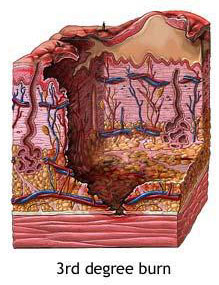
Burn Injuries
Contact The Crecca Law Firm to request a free consultation and information on options after a burn injury.
 Severe and permanent injuries can result from burns. Burn injuries are among the most painful and medically complicated injuries to treat and often require long recuperation and rehabilitation periods. The Crecca Law Firm has extensive experience litigating burn cases. We collaborate with medical researchers, engineers and healthcare providers to prosecute civil cases against wrongdoers and to help burn injury victims. We seriously pursue claims that will help burn victims and their families deal with the devastating consequences of electrical burns, liquid burns, thermal burns, industrial explosions, chemical burns, radiation burns, and fires in structures such as homes, apartments, offices, dormitories, hotels, and schools.
Severe and permanent injuries can result from burns. Burn injuries are among the most painful and medically complicated injuries to treat and often require long recuperation and rehabilitation periods. The Crecca Law Firm has extensive experience litigating burn cases. We collaborate with medical researchers, engineers and healthcare providers to prosecute civil cases against wrongdoers and to help burn injury victims. We seriously pursue claims that will help burn victims and their families deal with the devastating consequences of electrical burns, liquid burns, thermal burns, industrial explosions, chemical burns, radiation burns, and fires in structures such as homes, apartments, offices, dormitories, hotels, and schools.
Contact The Crecca Law Firm to request a free consultation and information on options after a burn injury.
Burns are incredibly painful because the nerve endings are damaged when skin is burned. Nerve damage results in intense pain, which may become chronic. Burns can also affect one’s blood vessels, bones, muscles, and even the respiratory system can be damaged with possible respiratory failure and airway obstruction. Significant urns can lead to permanent physical disfigurement, organ failure and even death.
A burn injury is one of the most expensive types of catastrophic injuries to treat. Aside from initial hospitalization, significant costs also include subsequent hospital admissions for reconstruction and rehabilitation.
Serious burn injury can also alter one’s appearance and present physical challenges that affect one’s ability to earn a living and lead a normal life. A burn victim may also suffer from significant emotional and psychological trauma, as well as ongoing financial loss.
Types of Burns:
- First Degree Burn: a first degree burn damages only the outer layer of skin, or epidermis. A sunburn is typically a first degree burn. A superficial burn is usually red and turns white if you press on it. A first degree burn heals by itself in three to six days. Hospitalization is required only if fever, dehydration (not enough fluid in the body) or uncontrollable pain develops.
- Second Degree Burn: a second degree burn involves the entire epidermis, the top layer of the skin, and some portion of the dermis, the second layer of the skin. Second degree burns can cause blistering, and deep second degree burns are dry and may appear ivory or pearly white. A skin graft is usually recommended for deep second degree burns.
- Third Degree Burn: a third degree burn destroys the epidermis, first layer of the skin, and dermis, second layer of the skin. Third degree burns are dry, with a dark brown or leathery appearance. Most third degree burns larger than 3 centimeters in diameter are best treated with removal of dead tissue, immediate skin grafting, and long-term use of compression garments to minimize scarring.
- Severe burns: Severe burns are a devastating injury, both physically and emotionally. Persons with severe burns may be left with permanent physical disabilities: loss of mobility, disfigurement, scarring, infection, muscle or tissue damage, nerve damage, respiratory system damage, loss of a limb, and permanent mental disabilities: nightmares or flashbacks from the traumatizing event and anguish from loss of a friend or family member. Severe burn injuries often necessitate long-term medical care, nursing care, physical therapy, and psychological care.


